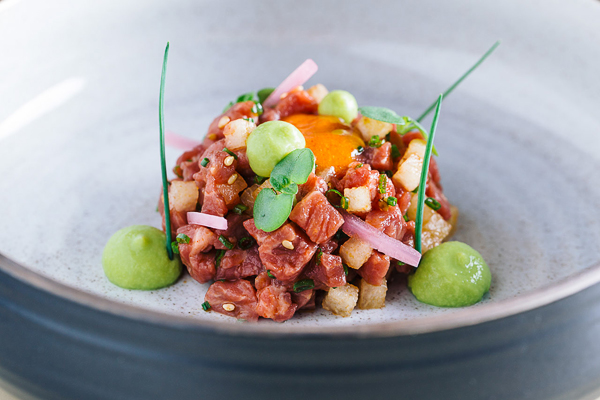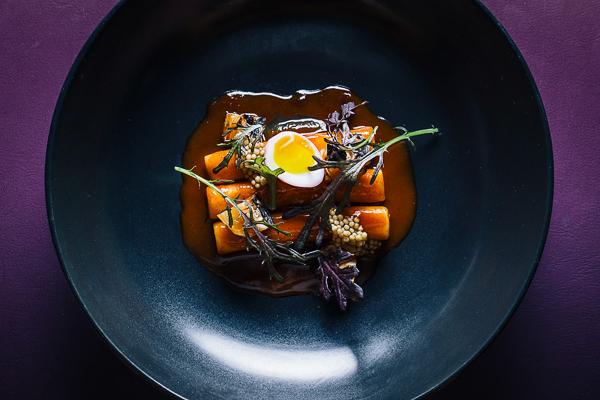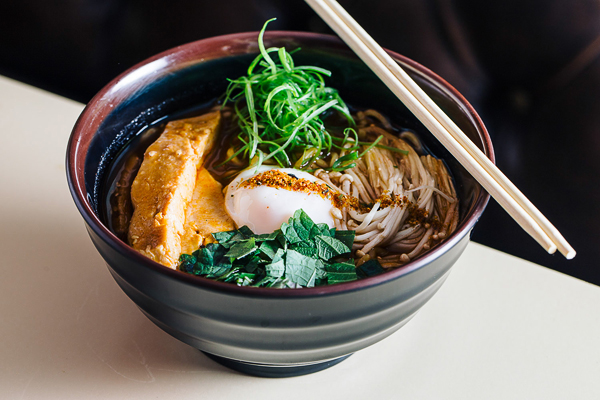Two young students meet at the finest culinary school in America. He’s Korean, born near Seoul; she’s Vietnamese American and straight out of Cicero. Full of ideas and confidence, they fall in love, move to the suburbs, and open a Korean fast-food kiosk in the Asian food court of a grubby mini-mall. Bibimbap, bulgogi.
Immediately they gain a following and think, Hey, we’re already paying rent—why don’t we open an after-hours, prix fixe, BYO private table in our kitchen? Bookings pile up, critics coo, the couple get engaged. Her proud and adorable mother works the cash register. All that’s left is setting a wedding date.
Is Hanbun a restaurant or a rom-com script?
David Park and Jennifer Tran, both 27, have an irresistible story, and one might be inclined to like their operation before even tasting the food. That optimism would be rewarded. The unusual Westmont spot quickly became one of my favorites of 2016. The fact that it’s in a bleak shopping center, where a skylight adorned with flashing LED raindrops casts a dim glow on fast-food counters with generic names like Chinese Cafe and Oriental Food House, only adds to the unlikely charm.
When my group of six arrived for the seven-course juhnyuk (dinner) tasting menu ($72), armed with a six-pack, a cabernet, and a vin santo, the only signs of life in the food court were aproned men sweeping up. Then the canvas curtain concealing Hanbun’s exterior lifted. Behind the counter, in a tiny storage space lit by fluorescent bulbs, was our table set with crisp linens, elegant stemware, and a tasteful bouquet of hydrangeas and lilies. Park himself was wedged in the back corner at a cooking station smaller than a coat closet.

“I hope you enjoy the amuse-bouche,” Tran said after pouring drinks. Then she presented me with a shrimp cake topped with a flower-shaped slice of daikon radish and moored by sticky gochujang, the Korean condiment made with rice, chilies, and soybeans. Next: a mound of gorgeous, glistening beef tartare surrounding an egg yolk that had been mixed with red chili flakes and then reassembled to look like a yolk again. Diced pickled Korean pear nestled into the stunning tartare, tiny toothpicks of pickled onion jutted from it, and dots of cucumber pudding calmed the stormy flavors. A three-star dish from a no-star kitchen.
Two creations in particular showcased Park’s rare skill with textures. He pan-fried his tteokbokki—the soft rice-and-fish-cake snack famous in Korean markets—in schmaltz, lending it a sticky-rich depth, then served it with a quail egg, pickled cabbage, and mustard seeds. His pearl barley porridge sounded emphatically unsexy, but it was as exquisite as the most refined risotto. Thick and studded with garlic-sautéed edamame, eyelash-size pickled honshimeji mushrooms, and wispy pea tendrils, it delivered surprising bursts of vinegary acidity and a brilliant crunch from puffed rice. I’ve never enjoyed porridge more deeply.

Sometime during the fifth course, woozy from the graciousness and creativity, I briefly forgot where I was. When I looked up from my lovely pork belly flanked by sunchokes prepared three ways (in a crisp croquette, in pickled slices, and steamed, shaved, and deep-fried into a chip), it hit me: Oh, yeah, we’re in the back of a fast-food joint.
Before that realization could shatter the spell, the penultimate course arrived: misugaru. A roasted grain powder that Park’s grandmother fed him as a boy, here it’s mixed with yogurt pudding, black sesame crumble, and gelatinous cubes of matcha-kudzu mochi. The result landed somewhere between a granita and a frozen custard, and I adored it.
The dissonant environs intruded again during the final course: A dense financier cake topped with smoked chestnut cream and sprinkled with powdered clementine peels got annihilated by fumes from the Pine-Sol that had been doused on the mall’s floors. Not the accompaniment Hanbun was looking for, but hey, that’s life in a food court.
I returned to Hanbun for a weekday lunch and found the food court mostly empty—a few office workers eating egg rolls, a Chinese family slurping noodles, and an old man with a spoon in his shirt pocket getting ramen to go.
Unlike the fussy joys of the dinner menu, Hanbun’s nine-item lunch menu leans to simple satisfaction. Dishes look like food court fare yet show an uncommon attention to detail. Park hasn’t reinvented the Korean staples; he’s simply refined them in thoughtful, nuanced ways.
His steamed pork bun, a perfect little sandwich, layers white kimchi over coffee-flavored pork belly and ssamjang, a sweet-spicy paste. And even without serving bibimbap in a scorching stone pot, Park manages to create that dish’s familiar crispy texture by topping tender chicken and egg with crunchy puffed rice. Bulgogi, which I’ve come to accept at local Korean barbecues as a pillowy mush or chewy beef gum, gets marinated overnight at Hanbun, sliced thicker than usual, and grilled into caramelized chunks, whereupon it’s topped with arugula, apple strips, and scallions in a soy-sesame vinaigrette.

I’d put Park’s Korean noodles head to head with David Chang’s legendary ramen at Momofuku Noodle Bar in New York. A spicy, scallion-topped, red-chili-tinged chicken broth comes with marinated chicken and enoki mushrooms that mirror the elastic texture of the slow-cooked noodles. And, oh, that perfect soft-cooked egg. Park pampers it at two different temperatures, first circulating it in a warm water bath before dropping it into a pasta cooker. One poke and a couple of swirls, and it coats everything in the bowl with a thin, custard-like luster. For $9.95, this dish, listed on the menu as ramyun, triggers absurd levels of happiness.
My lunch ended with the Korean Table—an $8.55 feast that includes a stew of smoky pork belly and kimchi served with banchan (side dishes) of chili-glazed dried shrimp, yuzu potato salad, grilled honshimeji mushrooms, salted shrimp with sautéed zucchini, and napa kimchi.
After lunch, I sat down with Park and Tran to hear more of their story. “When we were at the CIA [Culinary Institute of America], I told Jen, ‘I want to go all over the world and work at all the best restaurants,’ which is what every culinary student says,” recalled Park. During a one-day stage at Grant Achatz’s Alinea, Park suffered a crisis of confidence at the Cryovac machine and realized he wasn’t ready for a big-time kitchen. Then, in Tran’s words, “he got fat and went to Disneyland.”
Seven years and many kitchens later, here they are in Westmont, pouring their hearts and hours into Hanbun. (Tran somehow juggles two other food-service jobs.) As for the engagement? “This is our premarriage counseling,” Tran says, motioning to the restaurant. The joke is that if they can survive running Hanbun, they’ll get married. In the establishment’s first year, they’ve said no to a number of potential investors while they decide whether to expand, franchise, or go in another direction.
Ultimately, they’d love to open a bigger restaurant in the suburbs where Park can do his thing for a larger audience. “I want to take Korean cuisine and turn it upside down,” says Park. “I want to blow someone away just by feeding them a piece of duck.” Whichever way they go, Hanbun is not the happy ending to Park and Tran’s story. It’s the promising prologue.



